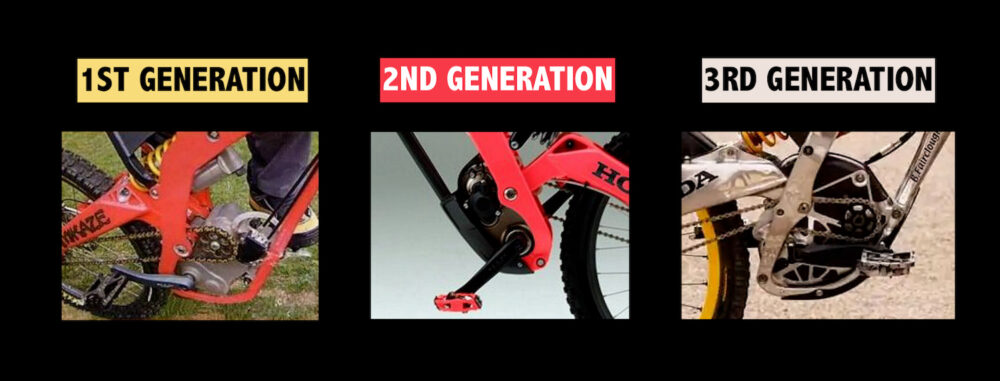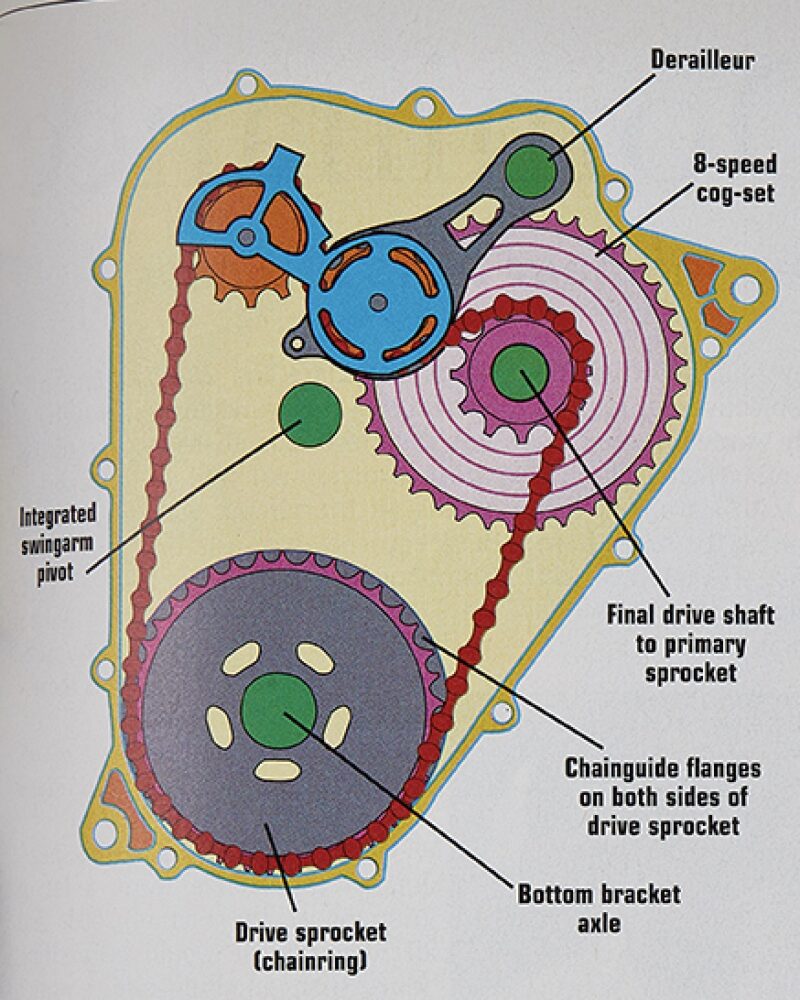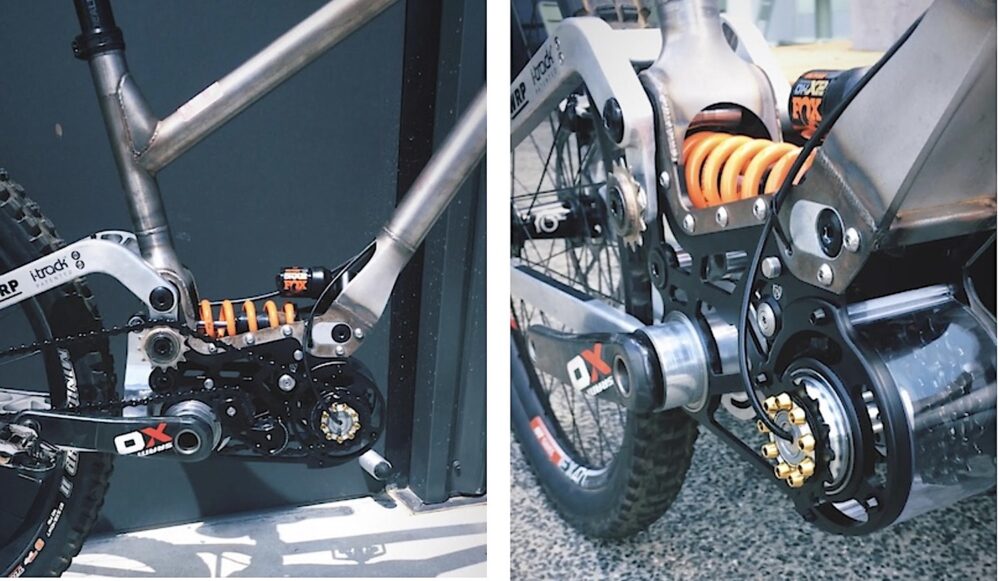Table of Contents
Honda is the largest motorcycle manufacturer by a huge margin, and they’re one of the largest car manufacturers too. They have built Formula 1 cars, jet aircraft, robots, boat engines, and lots of power equipment.
The company channels around 6% of their annual revenue into research and development, making them particularly well-known for its innovation.
But Honda’s innovation isn’t just limited to products with motors. Two decades ago, they were experimenting with some top-secret bicycle gearbox drivetrains. And after a handful of seasons on the downhill World Cup MTB circuit, the Honda gearbox bikes had won the world championships and five World Cup rounds.
Unfortunately for us, the gearboxes that Honda developed were never meant to be commercial products. It turned out that Honda poured money into this program purely to challenge the minds of their engineers.

As the patents on these gearboxes are expiring soon, I thought this would be a great time for us to analyse all three generations of the Honda bicycle gearboxes. You’ll learn about the designs and how they all work, we’ll examine why there aren’t more gearboxes following similar designs, and we’ll look into the next generation of gearboxes in this space.
But first, let’s find out the advantages and disadvantages of using a gearbox over a derailleur drivetrain for mountain bike racing.
The Advantages of a Gearbox Drivetrain for Racing

One big advantage on a downhill race bike is the reliability boost via additional ground clearance. Derailleurs hang low on a bike and are susceptible to damage from rocks, sticks and crashes. On a short-timed run, a broken derailleur, or a missed shift, can be the difference between winning and losing.
Additionally, a gearbox has the ability to instantly shift gears without the need to pedal. This allows riders to pre-load the perfect gear before a corner, in the air, or while riding through a rock garden.

Speaking of rough terrain, by moving the shift components to the centre of the bike, the rear suspension performance can be improved due to a reduction in unsprung mass at the rear wheel. This allows the rear suspension to react faster, increasing traction, and the bike can also handle better with the weight central and low.
A modest boost in performance could also be found in adverse riding conditions. Derailleurs and jockey wheels can get jammed with mud and grit, affecting their ability to shift or operate efficiently. A gearbox seals away many of these critical drive components.
But really, the biggest advantages of bicycle gearboxes are realised at the consumer level, as you get an incredibly low-maintenance drivetrain, that’s weather resistant, crash resistant, and with fewer components that will wear.
Why Are Derailleurs Still Common in Racing?

Simply put, derailleur drivetrains are the lightest gear system with the highest drive efficiency, which in bike racing, is the perfect recipe for winning. This is why almost all bicycles raced at the top level use derailleurs.
Mountain bikes with derailleur drivetrains are, at minimum, one to two kilograms lighter than gearbox bikes (2.2-4.4lb). Derailleurs can also transfer more of your pedal power to the rear wheel – it works out at around 5% more power than if you were using a Pinion gearbox (in ideal riding conditions) but this number can narrow depending on the power output and cadence of the rider, along with the riding conditions, lubricants used, chain contaminants, drivetrain wear, and much more.

In addition, derailleurs allow for a very broad variation in bicycle frame design, as a rear hanger is the only necessary infrastructure for installing gears on a bike. In comparison, the packaging requirements of a gearbox significantly limit the ability of a frame designer to optimise the suspension layout.
And lastly, derailleur drive components can be quickly and easily replaced, which is ideal for mechanics who have limited time for race repairs. And it’s even more ideal for derailleur manufacturers who really like selling derailleurs.
Right, let’s get into what you’re really here for – the Honda gearbox tech!
The Honda CVT Gearboxes

The first two Honda gearbox generations are, by far, the most fascinating – but unfortunately, there are very few photos and limited information about them outside of their patent.
When you think of a bicycle gearbox, you often think of big spur gears meshing at the crankset (Pinion), or much finer planetary gears rotating around sun gears inside a rear hub (Rohloff, Shimano).
The first two generations of Honda gearboxes were neither. And they didn’t even have set gear ratios! They instead used a camshaft and a series of levers to change the drive ratio.

Very few people knew of these gearboxes, and even fewer understood how they worked. Stick around until the end and I guarantee a cam and lever bicycle gearbox will make sense to you.
Why did Honda design their earlier gearboxes this way?
Firstly, you got to choose from an infinite number of gears between two set points – this is known as a continuously variable transmission, or CVT. Shifting was instantaneous, and the gearbox would never ‘skip’ like a poorly-tuned derailleur.

The CVT gearbox was also particularly compact by the second generation – almost half the volume – and in theory, could be quite efficient too.
Unfortunately, the Honda CVT boxes were seen just a handful of times at bike races and trade shows, and were never raced on the World Cup circuit. We will never know why Honda shelved these earlier gearboxes, but that’s ok because they had another gearbox ready to go.
The Honda Derailleur in a Box



The G Cross Honda team burst onto the downhill World Cup circuit in 2004 with a bunch of talented riders. The Honda bike ended up winning the first World Cup race it was entered in, instantly proving the carbon-shelled gearbox was the real deal.
For more than a year, we could only guess what was inside the third-generation gearboxes, as they were racing with them long before anyone was allowed to look inside. In fact, Honda mechanics performed all gearbox maintenance hidden from view, and the gearboxes were never stored with the bikes. Instead, the gearboxes stayed inside hotel rooms with the mechanics to not only prevent theft but to keep the design a secret.

After the patents were eventually made public, we found out that the latest gearboxes were nothing particularly genius. The solution was a derailleur-in-a-box: a 7-speed gear system that used the same components as a regular drivetrain, but was all sealed away from the elements.
While not as innovative as the CVT boxes, the internal derailleur drivetrain still achieved Honda’s goals of shifting without pedalling, reducing the unsprung mass at the rear wheel, and creating a gear system that was less susceptible to damage.
The gearbox worked by transferring pedal power into a sprocket located on the crank spindle. When this sprocket turned, it would drive the internal chain onto a small cassette where the gear ratio was selected. The cassette then directly drove the external sprocket, which went on to drive the rear wheel.


The freewheel for this drivetrain was located at the crank spindle, which meant that whenever the rear wheel was moving, the internal chain was running, and the gears could be changed without pedalling.
A really cool thing about this miniaturised derailleur drivetrain was that the chain line was always straight because both the sprocket on the crank spindle and the derailleur moved in unison when you shifted.
A straight chain line is key for ensuring a high drive efficiency – some quick maths suggests this drivetrain would likely operate within 2% of a regular derailleur setup, but it could be more efficient in adverse conditions.
While the Honda gearbox was refined and race-proven almost 20 years ago, it’s worth noting that PeteSpeed had a very similar patented gearbox on bikes at around the same time. This design was later licensed by Hayes, but I don’t think it ever made it onto any production bikes.
The Downsides of a Derailleur in a Box

As a derailleur-in-a-box uses existing bike components and offers a high drive efficiency, it seems like an ideal solution for a gearbox bike. So, why aren’t bike manufacturers working on this tech for consumers?
One issue is the physical size of the gearbox – when the box becomes too large, it considerably limits frame design. Just look how big the Honda box was when it was using a tiny road bike cassette with just over 200% gear range. If we were to squeeze in a modern cassette from a 1X drivetrain (eg. 10-52t), it would be monstrous!
To maximise bike compatibility, gearboxes are currently being designed around eBikes as well as regular bikes. With the extra packaging constraints of a motor and battery, this makes a derailleur-in-a-box even less commercially viable.
But despite these downsides, people are still forging on with this concept.
The Next Generation

Williams Racing Products has recently been teasing a working prototype of a derailleur in a box. This design is impressively compact, and might even fit a standardised frame design in the future. But again, the gear range is limited to the cassette size that will fit inside their box.
Cesar from UNNO bikes holds a recent patent for a similar gearbox, so there are likely working prototypes in existence. The interesting thing is that there is no derailleur inside this gearbox, instead, it’s the cassette that slides back and forth. This is cool, but it creates further packaging issues due to the extra gearbox width.

Three years ago, I made an in-depth video about Shimano’s 13-speed gearbox patent that uses a form of derailleur. Again, a very cool design, but right now in 2023, there are no updates on its development.
And Nicolai bikes have always been tinkering with gearboxes, however, the most recent derailleur-in-a-box prototypes are now a decade old.
Ok, let’s switch gears for a bit, and find out how Honda’s first and second gen CVT gearboxes worked. I think you’ll find this bit particularly fascinating!
How Does the Honda CVT Gearbox Work?
Note: this section is best watched in my Honda gearbox video (11:18) as the visuals will help a lot.

Here’s a cross-section of the CVT gearbox to help us understand it. The crankset is located down the bottom and the output sprocket is located up the top.
We can break the gearbox into three key sections:

The first section increases the rotation speed of the sprockets inside the gearbox. This allows the final sprocket to spin about 11x faster than the crankset – meaning this gearbox moves at around 1,000RPM under a typical rider cadence (90RPM).
The speed of the sprockets is increased using three gear sets: one from the crank spindle to a separate assembly, another gear set back the crank spindle, and another to a special sprocket housed on a camshaft.
The second section is all about turning rotation into a repetitive linear movement using a camshaft. The last sprocket from the first section of the gearbox is connected to an eccentric cam, so every time it spins, a series of four connecting links can move up and down. The best way to understand what’s going on here is to imagine a piston going up and down.

We now need to look at a line drawing to understand what happens next, and this is where it gets a bit tricky to follow. The lower link is the camshaft, and the upper link is connected to the final section of the gearbox, the one-way clutch. Every time the camshaft moves up and down, it moves the upper link up and across, along a circular path.
The final section is all about turning our reciprocal movement back to rotary movement. As the upper links move on a circular path, Honda employed a one-way clutch so that only the rearward movement would drive the external sprocket, while the forward movement would simply “freewheel” – to put it into bike terms. This clutch would operate similarly to an Onyx rear hub, offering instant engagement.
But here’s where things get crazy. Our external sprocket would not move in a totally smooth motion if the clutch is constantly engaging and disengaging, so the geniuses at Honda designed a wavy gear set that can offset these oscillations.

And what about the infinite gears?
Well, a twist shifter at the handlebar adjusted the geometry of the drive links. When the shift actuator arm was high – as shown in this upper gearbox line drawing – the camshaft pushed the clutch a shorter distance per rotation than when the shift actuator arm was down. The distance the clutch moved in the highest gear was about 3x further than the lowest gear – resulting in a ~300% gear range.
The geometry of the links could be manipulated anywhere between these two points when shifting, and this is what gives us an infinite number of gear options.
Summary

Two decades ago, Honda did something very impressive. To create a gearbox bike that could keep up with derailleur bikes at the top level was unheard of back then, and hasn’t been done since.
Their derailleur-in-a-box design was so simple and effective in execution, I’m surprised we haven’t seen it replicated in downhill mountain bike racing where the design clearly works.
That said, the Honda and PeteSpeed patents expire soon, and we’re seeing new prototypes coming through – so perhaps the next derailleurs-in-boxes are closer than not.
The first and second-generation CVT gearboxes were truly innovative, with their camshafts, links and one-way clutches. I’d love to know why the idea wasn’t pursued further, but I suspect that’ll stay as Honda’s little secret.









